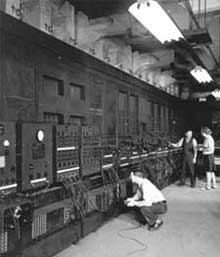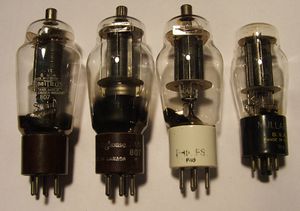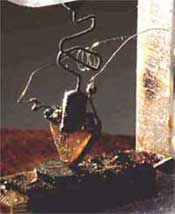Early Microelectronics
At one time electronics were relegated to just a few areas, such as radio and television. A big reason for this was because electronics themselves were big. If you’ve ever seen pictures of early TV sets and radios from the 1940s and 1950s they were large, cabinet-size devices that looked more like furniture than like cutting-edge electronics. And computers? The predecessors of the latest 12 inch, five pound laptops were machines like ENIAC, the world’s first general purpose electronic computer, which was developed in the 1940s. ENIAC was so large it filled entire rooms. Although ENIAC was a marvel for its time, its computing power is dwarfed by a simple modern pocket calculator. So, how did electronics infiltrate just about every appliance we use? They got smaller, and smaller, and smaller. Engineers have spent a good part of the last 50 years shrinking electronic components. This is the field of “microelectronics,” the guts of modern electronics.
In the early days of electronics, that is before the 1950s, the basic electronic device was the electron tube (which is also commonly known as a vacuum tube), which had begun life years earlier as a modified light bulb, and stayed about that size. Electron tubes made early electronics such as radio possible, but they had some serious limitations. Their filaments burned out just like a light bulb, and to make something work you needed lots of them. ENIAC, for example, needed 18,000 tubes to function. But electron tubes were also incredibly useful. In a radio or phonograph, they could take an extremely weak signal and amplify it loudly enough so that it could fill a room. The electron tube could also be used like a switch, but unlike a regular switch it had no moving parts and so it could switch on and off incredibly fast. Computer engineers, who used electrical switches to construct elaborate “logic” circuits, chose to use the electron tube despite its size and tendency to fail.
During World War II, things began to change. Engineers undertook a bold experiment to try to pack an entire radar set into an artillery shell. They called their new device a “proximity fuse,” because it could destroy by being near a target rather than requiring a direct hit. Even though they were a success, proximity fuses still relied on electron tubes, albeit, quite tiny ones. After the war, as missiles and rockets emerged, there was an increasing need for compact, rugged electronic systems for communication and navigation. The search was on for smaller and smaller electron tubes.
While some engineers worked on building better and smaller electron tubes, others were looking for ways to do away with tubes altogether and turned to semiconductors, a class of materials valued because they could be used as diodes (a diode is a one-way valve for electricity). One was Russell Ohl of Bell Telephone Laboratories. Ohl and his fellow researchers discovered that putting two slightly different types of a semiconductor called germanium together produced a device that acted like a electron tube diode.
Ohl’s work was important, but an even bigger discovery was made in 1947 when John Bardeen and Walter Brattain stumbled on the “transistor,” a slice of germanium with a few carefully placed wires touching it, that was not only a valve but also an amplifier. This was the point-contact transistor. As an added bonus, the transistor produced a fraction of the waste heat and was tiny compared to an amplifier tube—the whole device could fit on the end of a finger. Not long afterwards William Shockley, also of Bell Labs, made the fragile transistor into a rugged and practical device when he invented the “junction” transistor, a sandwich made up of layers of germanium. Bell Labs announced the point-contact transistor in 1948 and the junction transistor in 1951. The germanium transistor was a milestone, but it was unreliable and engineers sought out new materials with which to construct transistors.
They found an answer in silicon, another semiconductor that had been used in diodes. Silicon proved to be a better material for making transistors. It was this type of transistor, introduced by Texas Instruments in 1954, that revolutionized the technological world. Missiles became more accurate with onboard transistor guidance systems and computers became small enough to fit on board an aircraft. Perhaps the most famous transistorized product from this era was the pocketsize radio. By the end of the 1950s, the little transistor had replaced the hot, unreliable electron tube in nearly every existing type of electronic system. It also made electronic devices smaller, cooler (in temperature, that is), and less expensive.


